WiFi Password Hacking: How Hackers Break In (And How to Stop Them)

The wireless connections we depend on every day are not as invisible as they seem. Behind every WiFi network is a stream of constant communication, encrypted and beamed across spaces we can’t see but rely on endlessly. From laptops to smart bulbs, our devices ride this stream, and with it goes our personal data, passwords, and even our money if we’re not careful.
Knowing how hackers break into WiFi networks is the first key step toward staying secure. This blog will take you through their methods, explain how common security flaws are exploited, and show you how to set your own defenses in place. We will also discuss why hackers go after WiFi in the first place, the risks of poor network hygiene, and the measures both individuals and organizations need to take.
To make this article engaging and search-friendly, we will also suggest where images should go, connect each section with practical advice, and ensure that you leave with both awareness and actionable steps.
Why Hackers Target WiFi
If you’ve ever wondered why WiFi is such a tempting target for attackers, it comes down to convenience and reward. Unlike breaking into a server that requires bypassing multiple firewalls and corporate protections, WiFi offers a more direct opportunity.
-
Accessibility: A hacker within range can attempt to exploit a WiFi connection without stepping foot in your home or office.
-
Gateway to devices: Once inside, they don’t just gain internet access; they have a path to every device on that network.
-
Potential for profit: Personal information, banking credentials, and even company trade secrets can all pass through WiFi.
-
Anonymity: An attacker who hijacks your network can use it for malicious purposes, leaving you to take the blame.
Common Ways Hackers Break Into WiFi
Understanding methods of attack is critical. While we won’t provide exact step-by-step hacking instructions, here are the broad categories of techniques used, their logic, and why they succeed.
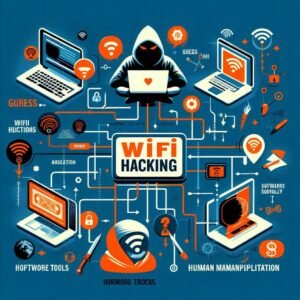
1. Weak or Default Passwords
One of the most common vulnerabilities comes from users who never change their default router credentials or who set overly simple WiFi passwords such as “12345678” or “password123.” Hackers use advanced dictionary attacks that quickly attempt thousands of guesses until the system lets them in.
2. Brute Force and Dictionary Attacks
Hackers use automated tools that try a massive number of possible password combinations. With today’s computing power, easy-to-guess passwords fall in seconds.
3. Packet Sniffing
Tools allow attackers to capture packets of data traveling across the WiFi. If the network uses outdated encryption such as WEP, these packets can be analyzed to reveal the WiFi key or user data.
4. Man-in-the-Middle Attacks
Once connected, hackers can position themselves between you and your internet access point, intercepting any communication. This allows them to spy, steal, or even alter the data as it moves.
5. Rogue Access Points
Hackers sometimes set up a fake WiFi access point with the same name as a legitimate one. Unsuspecting users connect to it, unknowingly handing their traffic over to the attacker.
6. Social Engineering
Not all WiFi hacks are technical. Sometimes, all it takes is tricking a person into revealing their password via phishing messages, fake tech support calls, or casual conversation.
The Risks of a Compromised WiFi
The danger doesn’t end with someone piggybacking on your network for free internet. The risks go deeper.

-
Data theft: Confidential documents, financial data, and personal messages can be intercepted.
-
Device takeover: Once inside, hackers can slip into other connected devices, including smart TVs, security cameras, or even medical equipment.
-
Bandwidth theft: Attackers may use your internet to carry out illegal activity, leaving you accountable for their crimes.
-
Business disruption: For companies, a single WiFi intrusion could expose trade secrets or customer databases.
-
Privacy invasion: Hackers can see which websites you visit and when, building a private dossier without your knowledge.
How to Stop WiFi Hackers
Prevention is possible, and while nothing is ever 100% immune, the right steps make breaking in so difficult that attackers move on.
Use Strong Encryption
Your router settings allow you to select the encryption type. Always use WPA3 where available. This is the latest standard, replacing WPA2. Avoid older protocols like WEP, which can be cracked in minutes.
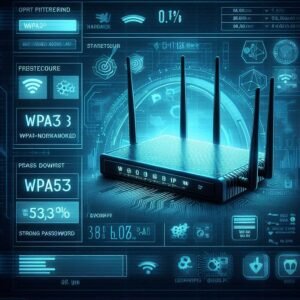
Strong and Unique Passwords
-
Create long and random WiFi passwords, at least 14 to 16 characters.
-
Avoid using dictionary words, names, or predictable patterns.
-
Change them regularly, especially if you share with guests or employees.
Update Your Router Firmware
Manufacturers release firmware updates to patch security weaknesses. Treat your router like any other device and keep its software up to date.
Disable WPS
WiFi Protected Setup (WPS) was designed to make connections faster but is notoriously insecure. Always disable it.
Hide or Rename Your Network (SSID)
While not foolproof, hiding your SSID or renaming it to something generic can reduce the risk of being instantly spotted and targeted.
Enable a Guest Network
Provide guests with a separate network. This isolates your main devices while still offering internet access.
Regularly Check Who is Connected
Many modern routers have a dashboard that shows connected devices. If you spot an unfamiliar one, it may signal an intrusion.
Use Firewalls and VPNs
A VPN encrypts communication between you and the wider internet, rendering intercepted data useless. Routers with built-in firewalls add a further barrier.
Public WiFi Dangers
It’s not just your home or office connection at risk. Public WiFi hotspots at airports, cafes, and hotels are often unsecured playgrounds for hackers.
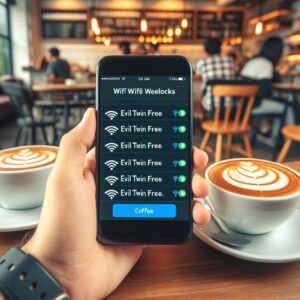
-
Attackers can create “Evil Twin” WiFi networks named after the café or airport, luring people in.
-
Shared networks with no password mean any user could see traffic from others.
-
Logging into banking or email accounts from such a connection is extremely risky.
What to Do Instead:
-
Always use a VPN when using public WiFi.
-
Avoid accessing bank or sensitive accounts.
-
Consider tethering from your mobile plan, which is usually safer.
Business and Enterprise-Level Risks
For businesses, compromised WiFi is more than a nuisance—it’s a potential disaster. Competitors, cybercriminals, and even insiders may exploit it. Risks especially increase with remote work and IoT (Internet of Things) connected devices.

Enterprise Fixes:
-
Use RADIUS authentication for employee logins.
-
Enforce strong device and network policies.
-
Segment corporate networks so attackers cannot move laterally.
-
Regularly audit and penetration-test company WiFi.
The Ethics of WiFi Hacking
It’s worth distinguishing between malicious hackers and ethical researchers (penetration testers). Learning how vulnerabilities work should not be about breaking into someone’s private network but about understanding weaknesses so they can be reinforced.
Legal hacking involves auditing your own systems or those you are explicitly authorized to test. Unauthorized intrusion into someone else’s WiFi is illegal and punishable by heavy fines or imprisonment in many countries.
Practical Checklist for WiFi Security
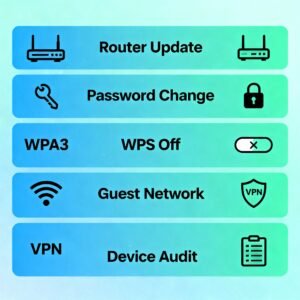
-
-
Update router firmware this month.
-
Replace weak passwords with a strong, unique one.
-
Turn on WPA3 encryption.
-
-
Disable WPS immediately.
-
Separate guest access from core devices.
-
Start using a VPN, especially on shared or public WiFi.
-
Audit connected devices regularly.
This simple list, if followed, is enough to put you ahead of the curve against most attacks.
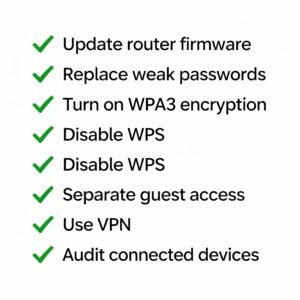
Future of WiFi Security
As WiFi evolves, so do its defenses. WPA3 is just one step in the cycle of advancing protocols. Future wireless standards will integrate artificial intelligence to spot malicious patterns, and routers will be smarter in how they isolate suspicious traffic. That said, the human element will always matter—because no technology can protect against someone handing over their password willingly.
Conclusion
WiFi is like the digital front door to your world. If it’s left unlocked or poorly secured, it’s only a matter of time before someone tries to come in. Hackers thrive on laziness, defaults, and ignorance—but with a little effort, most of their tricks can be stopped cold.
Securing WiFi doesn’t require advanced knowledge, only a willingness to treat your connection with the same seriousness as you would a bank account. The next time you set up or connect to WiFi, remember: you’re not just unlocking the internet—you’re unlocking your personal world.